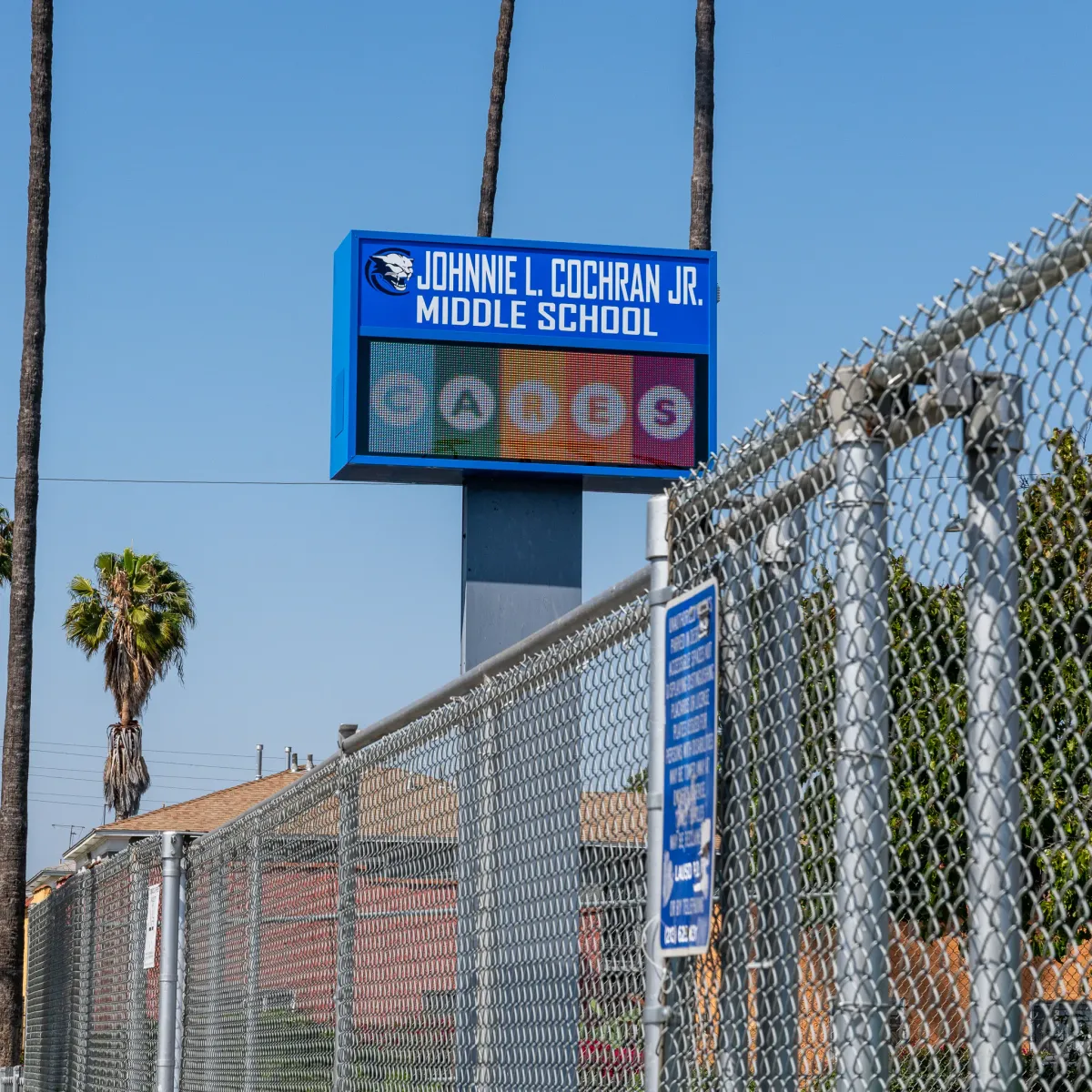
Students who attended Johnnie Cochran describe a culture that ignored bullying and publicly humiliated students in the name of discipline.
Armand Sears lll and Amarachi Ozoemena, currently high school seniors and active members of the grassroots organization Students Deserve, both attended Johnnie L. Cochran Jr. Middle School from 2015 to 2018. While neither had many interactions with Principal Gilberto Samuel, they spoke to Knock LA about the culture at Johnnie Cochran Middle School, and especially their experience as Black students.
“I’ve had some teachers who were not really hands-on,” Ozoemena says. “They did not really teach.”
Sears says experiences varied from classroom to classroom.
“It’s not even a gradient. It’s a checkerboard. It switches from teacher to teacher,” Sears says. “Some teachers are very chill, maybe a little bit too chill, let a little too much bullying go by. Some are too volatile [in response] to everything that’s happening inside the classroom, making it even more volatile.”
Bullying was an ongoing issue at Cochran. By both Sears and Ozoemena’s assessment, it was something school staff would let slide. Ozoemena says teachers would often “applaud mean students for just not being terrible.”
The students even say some teachers’ strategies to encourage academic achievement may have tacitly endorsed bullying.
“When I was in sixth grade, my teacher organized the classroom by grade. You would have tables for F students, for D students, for C students, for B students, for A students. If you had an F, you would sit at the F table, so everyone knew you were failing the class,” Ozoemena says. “I felt like that was so terrible, but I guess that was the way of disciplining students or encouraging students to do better. But I don’t think that was really encouraging. I think it was humiliating. I felt bad for the students who had a bad grade because now everyone knew and they could use that against them.”
Jaana Juvonen, a professor of psychology at UCLA, says the practice of separating students by grade is “quite honestly outrageous.” She says it creates “a hierarchy among students. There are those who have it and those who do not have it. To be put into those lower categories causes a lot of internal doubt, but can also spill out into kids having social problems.”
Juvonen calls the practice of splitting students by performance level “academic tracking.” She says research shows the practice is demotivating and detrimental to education.
“In these classrooms, very little learning takes place because many of the students, or enough of them, may be misbehaving due to the low expectations that that conveys to them,” she says.
Juvonen notes shifting academic expectations make middle school an increasingly pivotal time for student learning, especially in terms of proper preparation for high school.
“[Academic tracking] creates big challenges for the kids themselves,” Juvonen says. “When we talk about our educational system being so competitive, it is no longer the case that middle school preparation and grades don’t matter. They matter a great deal in terms of how prepared kids are to start high school… Once you’ve been placed in lower tracks, it’s really, really difficult to climb up.”
There are also long-term emotional impacts to consider. Juvonen has taught college students who themselves were once subjected to academic tracking. Many come to Juvonen crying after class upon hearing how harmful these practices are.
“Obviously, [these students] subsequently did remarkably well because they landed at UCLA,” she says. “But this is really very tough. [In middle school], who you are and what you’re capable of, that comes from adult authority. So, it is not easy to dismiss by any means.”
Dividing students by age was far from the only issue at Cochran when it came to disciplining students. For a 26-year period beginning in 1993, all secondary schools in LAUSD were required to conduct metal detector searches on a daily basis. During searches, staff pulled students – ostensibly at random – out of the classroom where they would be examined with a handheld scanner and have their belongings searched.The LAUSD board of education voted to end the practice in 2019, thanks in large part to pushback from Students Deserve and similarly-minded organizations.
Unfortunately, Sears and Ozoemena attended Cochran during the era of searches, and noticed Black students were disproportionately targeted.
“When we would get randomly searched, it would mostly be Black students and occasionally brown students here and there,” Ozoemena noted. She was searched multiple times during her seventh grade year at the school, which yielded nothing.
“When I was in seventh grade, I was searched two or three times,” she says. “They found nothing both times. I don’t know why they kept calling on me. They had, like, metal detectors to check you and your body. After that, they take your backpack. They check all the stuff. Your pockets. Your pencil packs. “
The point of these searches was unclear and – by Ozoemena’s account – they didn’t seem particularly productive.
“It felt like they were just thoroughly, actively trying to find a weapon or something,” she says. “Like they expected me to have one. They found an X-ACTO knife, right? Because it was my science class and I was using it. They were like, ‘Why do you have this?’ And I was like, ‘Because I have science class, which you just took me out of.’ It felt like they were trying to find a reason to get me in trouble.”
Juvonen believes random searches alongside grade-based separation creates a perfect storm that places vulnerable students at a considerable disadvantage.
“Putting [students] in homogenous groups – especially the low end – has been shown over and over again to be so detrimental to them personally and socially,” she says. “Searches that are biased similarly convey these attitudes and expectations about them. And, again, it’s very difficult for kids to cope with these kinds of low expectations and suspiciousness on the parts of adults to reinvent themselves when they go to high school.”
This was not the only time Ozoemena was subjected to seemingly arbitrary disciplinary action. Cochran had murky rules about student attire. While students were required to wear uniforms, it wasn’t uncommon for students to accessorize, and the logic behind what constituted a dress code violation was confusing.
“You weren’t allowed to wear red,” she says. “I wore a red sweater and I got sent to the office. They quite aggressively explained to me, ‘There’s gangs in this neighborhood. If you wear red, something might happen to you.’ And I was like, ‘I’m just a kid. What are you talking about?’ That school was so weird.”
Ozoemena says joining Students Deserve helped her better recognize some of the mistreatment at Johnnie Cochran. Both Sears and Ozoemena still have mixed feelings about their middle school experience today.
“Most of my experience, I would say, was not good,” Ozoemena says.
“The experience was okay at times,” Sears notes, “but okay was where it was best. It was mediocre at best. A lot of times, it was less than mediocre.”
